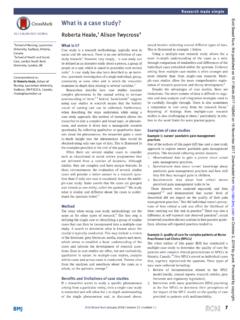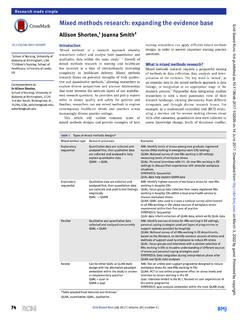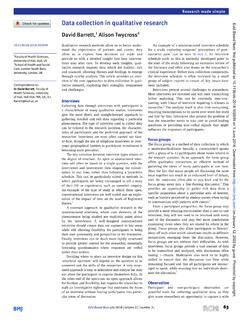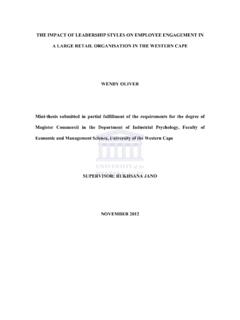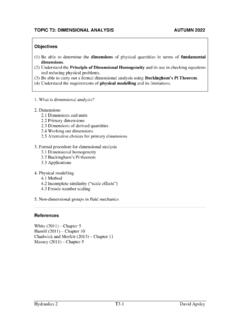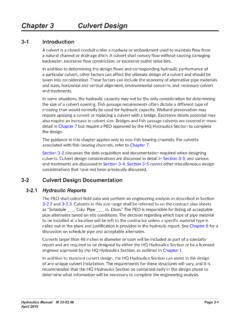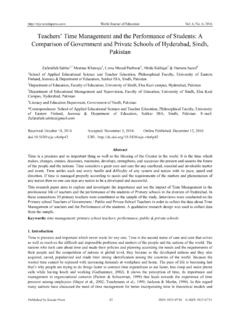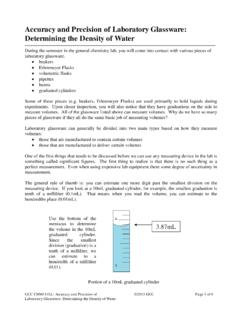Transcription of How to appraise qualitative research
1 Evid Based Nurs January 2019 | volume 22 | number 1 | 10 1 Nursing research and Diversity in Care, School of Health and Social Care, London South Bank University, London, UK2 Institute of Vocational Learning, School of Health and Social Care, London South Bank University, London, UKCorrespondence to: Dr Calvin Moorley, Nursing research and Diversity in Care, School of Health and Social Care, London South Bank University, London SE1 0AA, UK; Moorleyc@ lsbu. ac. ukHow to appraise qualitative researchCalvin Moorley,1 Xabi Cathala2 research made order to make a decision about implementing evidence into practice, nurses need to be able to critically appraise research . Nurses also have a professional responsibility to maintain up-to-date This paper provides a guide on how to critically appraise a qualitative research is qualitative research ? qualitative research concentrates on understanding phenomena and may focus on meanings, perceptions, concepts, thoughts, experiences or qualitative research examines how or why a phenomenon occurs.
2 It collects data in the form of words, texts and or images via interviews, observations, photographs or document reviews. qualitative research does not use discrete vari-ables like those used in quantitative approaches. In crit-ically appraising qualitative research , steps need to be taken to ensure its rigour, credibility and trustworthiness (table 1).Some of the qualitative approaches used in nursing research include grounded theory, phenomenology, ethnography, case study (can lend itself to mixed methods) and narrative analysis. The data collection methods used in qualitative research include in depth interviews, focus groups, observations and stories in the form of diaries or other , keywords, authors and abstractIn a previous paper, we discussed how the title, keywords, authors positions and affiliations and abstract can influence the authenticity and readability of quanti-tative research papers,4 the same applies to qualitative research .
3 However, other areas such as the purpose of the study and the research question, theoretical and concep-tual frameworks, sampling and methodology also need consideration when appraising a qualitative and questionThe topic under investigation in the study should be guided by a clear research question or a statement of the problem or purpose. An example of a statement can be seen in table 2. Unlike most quantitative studies, qual-itative research does not seek to test a hypothesis. The research statement should be specific to the problem and should be reflected in the design. This will inform the reader of what will be studied and justify the purpose of the appropriate literature review should have been conducted and summarised in the paper. It should be linked to the subject, using peer-reviewed primary research which is up to date. We suggest papers with a age limit of 5 8 years excluding original work.
4 The liter-ature review should give the reader a balanced view on what has been written on the subject. It is worth noting that for some qualitative approaches some literature reviews are conducted after the data collection to mini-mise bias, for example, in grounded theory studies. In phenomenological studies, the review sometimes occurs after the data analysis. If this is the case, the author(s) should make this and conceptual frameworksMost authors use the terms theoretical and concep-tual frameworks interchangeably. Usually, a theoret-ical framework is used when research is underpinned by one theory that aims to help predict, explain and understand the topic investigated. A theoretical frame-work is the blueprint that can hold or scaffold a study s theory. Conceptual frameworks are based on concepts from various theories and findings which help to guide the It is the researcher s understanding of how different variables are connected in the study, for example, the literature review and research question.
5 theoretical and conceptual frameworks connect the researcher to existing knowledge and these are used in a study to help to explain and understand what is being investigated. A framework is the design or map for a study. When you are appraising a qualitative paper, you should be able to see how the framework helped with (1) providing a rationale and (2) the development of research questions or You should be able to identify how the framework, research question, purpose and literature review all complement each remains an ongoing debate in relation to what an appropriate sample size should be for a qualitative study. We hold the view that qualitative research does not seek to power and a sample size can be as small as one (eg, a single case study) or any number above one (a grounded theory study) providing that it is appro-priate and answers the research problem.
6 Shorten and Moorley8 explain that three main types of sampling exist in qualitative research : (1) convenience (2) judgement or (3) theoretical . In the paper , the sample size should be stated and a rationale for how it was decided should be research encompasses a variety of methods and designs. Based on the chosen method or design, the findings may be reported in a variety of different formats. Table 3 provides the main qualitative approaches used in nursing with a short authors should make it clear why they are using a qualitative methodology and the chosen theoretical approach or framework. The paper should provide details on May 16, 2022 by guest. Protected by Based Nurs: first published as on 1 December 2018. Downloaded from Evid Based Nurs January 2019 | volume 22 | number 1 | 11 research made simpleof participant inclusion and exclusion criteria as well as recruitment sites where the sample was drawn from, for example, urban, rural, hospital inpatient or community.
7 Methods of data collection should be identified and be appropriate for the research collectionOverall there should be a clear trail of data collection. The paper should explain when and how the study was advertised, participants were recruited and consented. it should also state when and where the data collection took place. Data collection methods include inter-views, this can be structured or unstructured and in depth one to one or Group interviews are often referred to as focus group interviews these are often voice recorded and transcribed verbatim. It should be clear if these were conducted face to face, telephone or any other type of media used. Table 3 includes some data collection methods. Other collection methods not included in table 3 examples are observation, diaries, video recording, photographs, documents or objects (artefacts).
8 The schedule of questions for interview or the protocol for non-interview data collection should be provided, available or discussed in the paper. Some authors may use the term recruitment ended once data saturation was reached . This simply mean that the researchers were not gaining any new information at subsequent interviews, so they stopped data data collection section should include details of the ethical approval gained to carry out the study. For example, the strategies used to gain participants consent to take part in the study. The authors should make clear if any ethical issues arose and how these were resolved or 1 Useful termsTermDescriptionCredibilityCredibili ty is establishing the study s findings with reality. This demonstrates the believability or truth of the findings. It ascertains whether the study findings are believable based on the participants original data and participants questions how the study findings are supported by the data.
9 It identifies any bias that may have been present. It is the level to which the findings can be confirmed or corroborated. Confirmability is concerned with determining that data and interpretations of the findings are not made up by the researcher s imagination, but clearly derived from the checkingThis is a technique in which the data, interpretations, analytical categories and conclusions are fed back to the participants from whom the data were collected. This process strengthens the data as it allows participants to clarify and correct any errors and provide additional information if necessary. It can also highlight how participants and researchers view the data is the systematic approach and techniques used to ensure reliability and validity of the is the practice of critical self-reflection about oneself as a researcher. It involves looking at one s biases, preferences and preconceptions.
10 The researcher should reflect on their relationship to the participant, and how the relationship affects participant s answers to questions or decisions in the research . For example, how does being a nurse impact on interviewing a patient in your care?TriangulationTriangulation refers to the use of different ways of collecting or analysing data and the cross-checking of these to see if findings from different methods, different analysts, different theories or different reliability checks of sources show similar Trustworthiness is concerned with how the researchers establish the study findings as credible, transferable and refers to the level of which the study findings can be transferred to other situations. The reader should look at the detail of the study including the methods and rigour applied and compare this to their own situation to determine if the findings can be applied to their own 2 Example of research question and problem statementResearch questionHow do patients experience postoperative pain control management?

